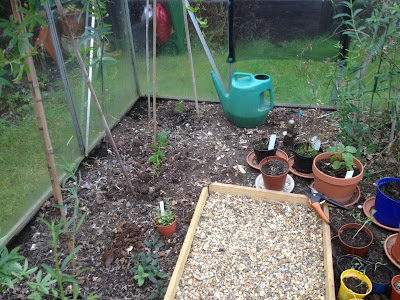So... it's been almost a year since I last wrote an entry on this blog. Last year was a bit hectic, but, I am hopeful that this year I will be able to keep it updated on a more frequent basis.
Okay, so, it's a new year. It's mid-February, and it's the time of year where I start thinking about the year ahead: What I want to grow, and what I want to breed in my tropical greenhouse. However, as I didn't grow or breed at all last year, I have an empty greenhouse and I need to start filling it up again! This weekend I have been clearing out the remains of dead plants from my last breeding season in 2011. I am quite excited about getting stuck in again this year.
Above: the now much clearer greenhouse, with most of the lifeless plants removed.
I am already getting some
Ruellia squarrosa plants growing, as these will form much of the ground cover in the tropical greenhouse and also provide an excellent host plant for the larvae of
Siproeta stelenes, which I enjoyed having bred two years ago. I am sowing seeds of two species of
Stachytarpheta as nectar sources:
S. jamaicensis and
S. urticifolia. Soon, I will be sowing a number of
Pentas lanceolata and
Vinca seeds which are also essential nectar sources.
Above: A lone Ruellia squarrosa clings on amazingly when all others had died. Also a pot of Ruellia seedlings to be planted around the greenhouse.
I am planning to breed my usual
Heliconius charitonia as well, and have found that a shoot of
Passiflora morifolia has emerged from the arid ground of the greenhouse. An unusual member of the passion flower family with large leaves, although, the Zebra has a tendency to favour the shoots of this species over others. Perhaps, because it is used by few other Heliconid butterflies. Other species of passion flower will also be introduced, hopefully
Passiflora vitifolia.
I do have plans to have more species breeding this year, but for the time being, I am getting the preparations done for the above species.
So that's the tropical greenhouse... Now, although I didn't breed any tropical butterflies last year, I did refocus on my outside garden, and worked on that quite a bit with the aim of encouraging bees and butterflies to visit. This was highly successful, and I intend to make continuous improvements to this for 2013 and will include updates in this blog too.
And on a very separate note, I have also set up and online store, so please check this out using the links below! However I am not intending to generate massive profits and I certainly haven't given up the day job, but I am hoping that I can make some additional money to support my hobby. The store itself will be selling a variety of seeds in order to attract butterflies into the garden, with the additional aim of increasing awareness of butterfly conservation in the UK and encouraging people to do their bit, by growing plants that attract the adult butterflies to breed, as well as feed. I will also sell excess seed stock from the tropical greenhouse, which may be of interest to any fellow butterfly breeders out there!
My online store:
Butterfly Garden Seeds
Follow us on Twitter:
@bflygardenseeds
Like us on Facebook:
Butterfly Garden Seeds
And there you have it: A brief explanation of the year ahead, and I have the intent this year to maintain an online diary of my tropical greenhouse and the butterflies being bred there.
.JPG)
.JPG)
.JPG)
.JPG)



.JPG)

.JPG)



